A simplified three-level example of a business capability map for an e-commerce company could look like this:
- Sales & Marketing (High-level capability)
- Digital marketing (Mid-level capability)
- Paid advertising (Low level capability)
- SEO
- Email marketing
- Content creation
- Customer Relationship Management
- Operations:
- Product sourcing
- Inventory management
- Fulfillment
- Quality assurance
- Customer Service:
- Issue resolution
- Returns handling
- Customer communication
- IT:
- E-commerce platform management
- Data management
- Cybersecurity
- Finance & Administration:
- Financial management
- Legal and compliance
- Human resources
Business capability maps, such as the one above, allow organizations to analyze, prioritize, and align their capabilities with strategic goals, enabling effective planning and decision-making.
📚 Related: 2023 Gartner® Magic Quadrant™ for Enterprise Architecture Tools
The key value propositions of any business capability map
When an organization undergoes change, such as a merger, acquisition, reorganization, or strategic shift, it's crucial to understand the existing capabilities and identify the desired capabilities needed to achieve the new objectives.
A business capability map provides several value propositions for an organization:
- Improved strategic planning:
Capability maps provide a clear overview of the abilities an organization has, which can help guide decision-making in line with strategic goals. They show where the organization has strengths and weaknesses and where investment could yield the most benefit.
- Alignment across the business:
By breaking down silos and providing a common language, capability maps help align different parts of the organization. This shared understanding can improve collaboration and drive initiatives that are beneficial for the whole organization rather than just individual departments.
- Gap identification:
A business capability map allows organizations to identify gaps in their capabilities, showing where they might need to invest in new technology, people, or processes to achieve their goals.
- Streamlining business processes:
By providing a clear view of the organization's capabilities, capability maps can help identify redundancies and inefficiencies in the business processes. They allow an organization to streamline operations, reducing costs, and improving efficiency.
- Risk mitigation:
Understanding where the organization's capabilities lie can help in risk mitigation. For example, if a company relies heavily on a capability that it isn't strong in, this poses a risk to the business.
- Driving innovation:
Capability mapping can also drive innovation. By understanding what capabilities they possess, organizations can identify areas for innovation and improvement.
- Enhancing customer satisfaction:
With a comprehensive understanding of its capabilities, a business can ensure it consistently meets and exceeds customer expectations, thus improving customer satisfaction and loyalty.
Examples and templates
Understanding the concept of business capability mapping is the first step, but visualizing and applying this tool effectively requires practical examples and flexible templates.
In this section, we'll provide several examples of business capability maps across different industries, alongside adaptable templates to guide you in creating your own.
However, it's crucial to note that these examples and templates should be viewed as starting points rather than prescriptive solutions.
Every organization is unique, with its own set of abilities, challenges, and goals. Therefore, while these resources can offer helpful guidance and inspiration, they may not accurately reflect the specific capabilities or structure of your organization.
Each company must define its own business capability map, customizing it to align with its unique strategy, structure, and operations. This individualized approach ensures your map accurately captures the essence of your organization, providing meaningful insights and a foundation for strategic decision-making.
With this in mind, let's explore some business capability map examples and templates that can provide a solid starting point for your mapping journey.



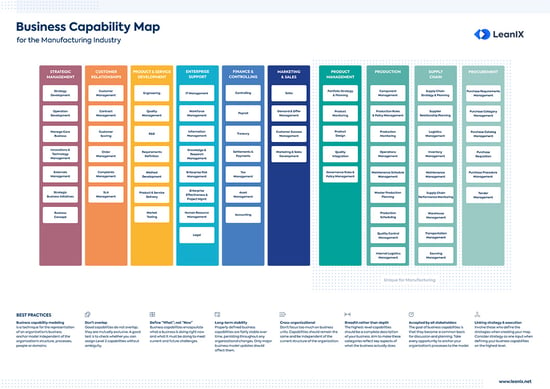
/LeanIX_Poster_Best-practices-to-define-energy-business-capability-maps.png?width=550&height=390&name=LeanIX_Poster_Best-practices-to-define-energy-business-capability-maps.png)
/LeanIX_Poster_Best-practices-to-define-energy-business-capability-maps.png?width=450&height=319&name=LeanIX_Poster_Best-practices-to-define-energy-business-capability-maps.png)

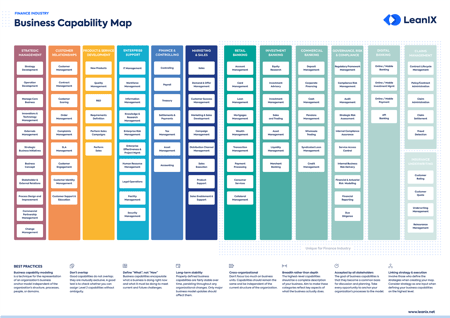

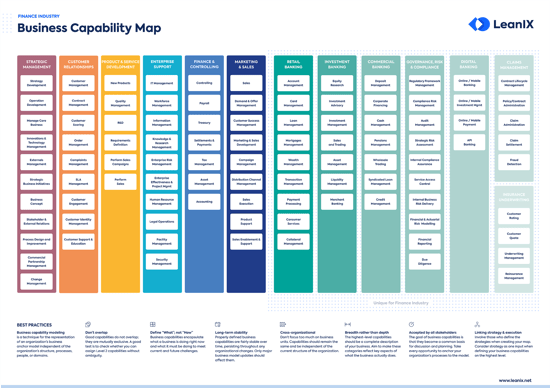
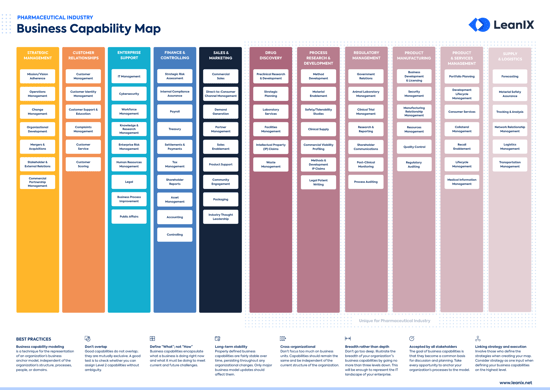
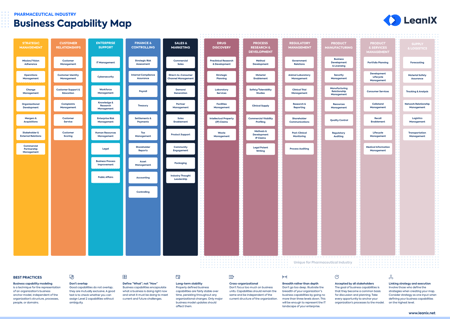

/EN-LX-BC-Model-Poster_Resource_Page_Thumbnail.png?width=450&height=319&name=EN-LX-BC-Model-Poster_Resource_Page_Thumbnail.png)

/EN-LX-BC-Model-Poster_Resource_Page_Thumbnail.png?width=550&height=390&name=EN-LX-BC-Model-Poster_Resource_Page_Thumbnail.png)
/Guide_BC_WhitePaper_Resource_Page_Thumbnail.png?width=260&height=171&name=Guide_BC_WhitePaper_Resource_Page_Thumbnail.png)
/Manufacturing-BC_Guide-WP-Resource_Page_Thumbnail.png?width=260&height=171&name=Manufacturing-BC_Guide-WP-Resource_Page_Thumbnail.png)
/EN-PaceLayering-Poster_Resource_Page_Thumbnail.png?width=260&height=171&name=EN-PaceLayering-Poster_Resource_Page_Thumbnail.png)

